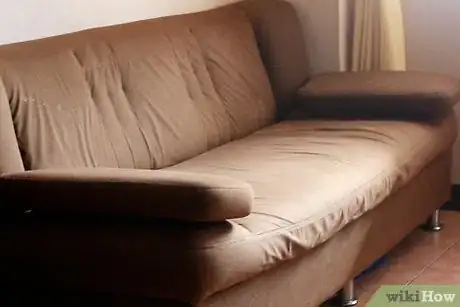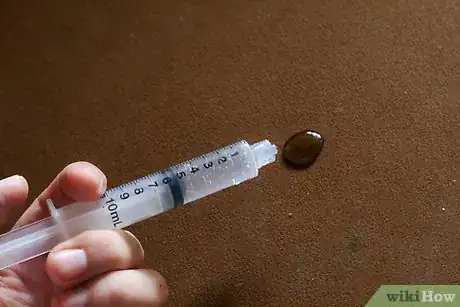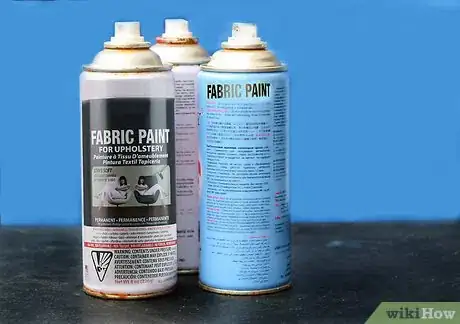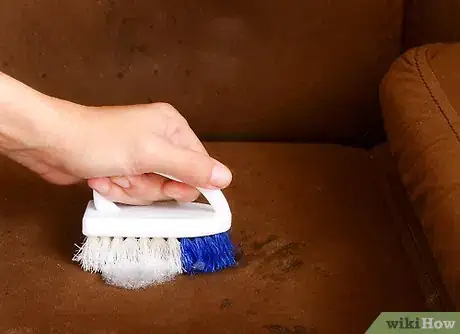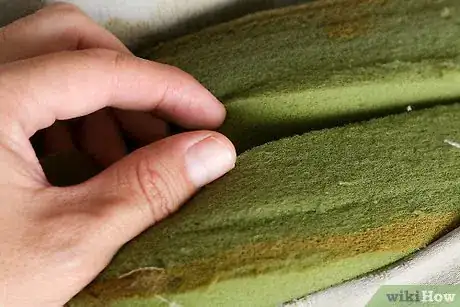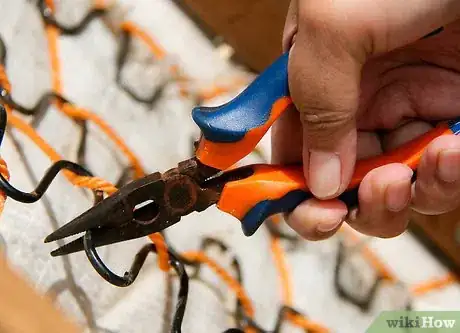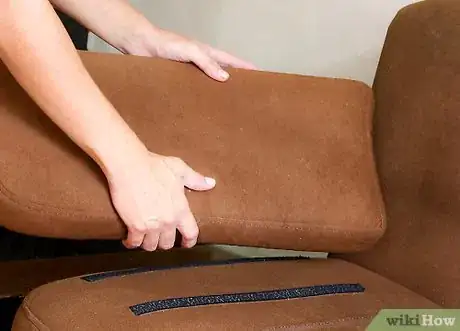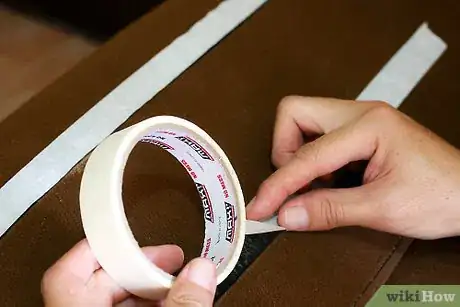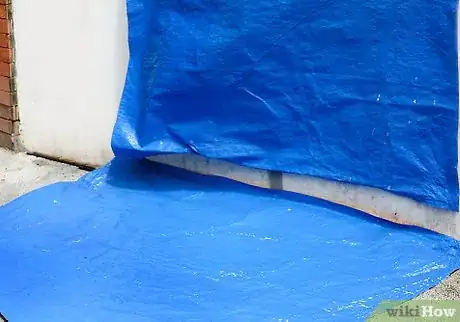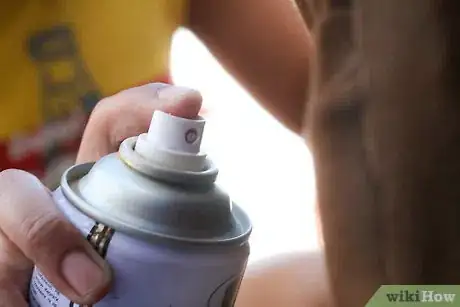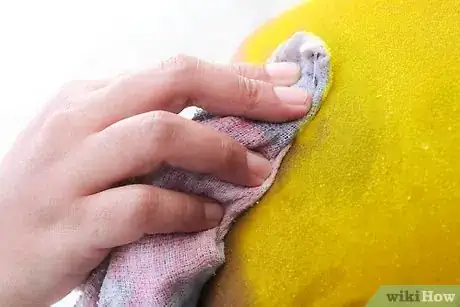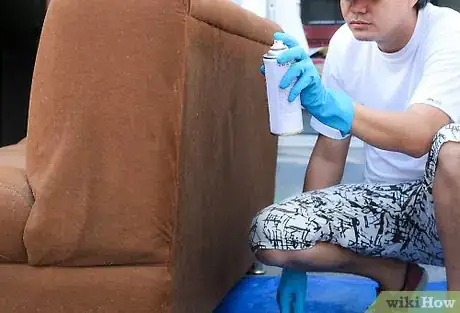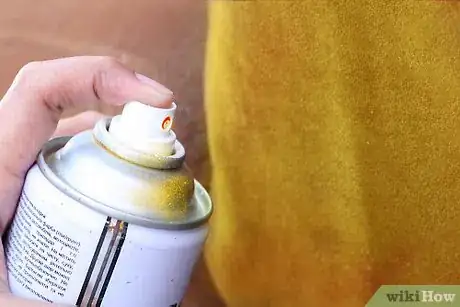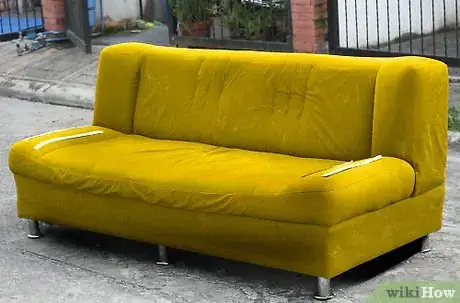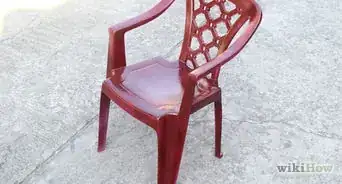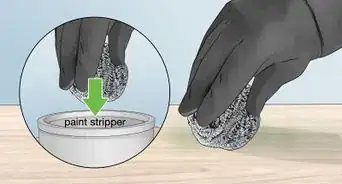This article was co-authored by Ez's Painting LLC. Ez's Painting LLC is a team of Painting Professionals based in Olympia, Washington. With more than twelve years of experience, the EZ's Painting team specializes in both commercial and residential painting projects. Ez's Painting LLC holds a contractor license in the state of Washington.
wikiHow marks an article as reader-approved once it receives enough positive feedback. In this case, several readers have written to tell us that this article was helpful to them, earning it our reader-approved status.
This article has been viewed 223,054 times.
An aging sofa or a less-than-beautiful one you've inherited from Aunt Jenny can be a real eyesore in your home. It can be tempting to throw it away and be rid of it for good but there is another way in which you can have your sofa, sit on it, and enjoy looking at it too. Slip covers are so yesterday––besides they require either a rather large outlay to purchase one (in just the right size if you're lucky) or some pretty skillful sewing. You can sidestep that solution by spray painting a whole new persona for your sofa instead.
Steps
-
1Select the sofa. Obviously, if you already have a dingy, past-its-used-by date sofa hanging around that you're just about to toss, it'll be the ideal candidate. Just be sure to ask all those invested in the sofa if it's okay to change its look.––You'll probably find everyone is in agreement with either changing it or ditching it provided they don't have to do the work! It's also a good idea to agree on the new color you'll spray paint the sofa before going ahead––ask your spouse, housemates or anyone else affected for their thoughts on preferred colors. If you're the only one in the house who really cares about color matching though, you're probably clear to get going. One other thing––this article is concerned with fabric-covered sofas. You'll have to find a different option for leather, polyester or vinyl covered sofas, which will need different treatment and coverings because they are generally paint-resistant.
- The sofa doesn't have to be one in your home. Maybe you saw a fantastic sofa down the local thrift store going for a song but hated the color or feel it needs sprucing up. Don't hold back.––The spray paint solution might be just the motivation needed to go ahead and buy that old couch.
- If you want to change a new sofa's color, be sure everyone agrees with the move. People who love the new sofa are bound to be rather more touchy about changing its look while it's still in great condition.
- One way to test the suitability of a couch for painting is to add a drop of water. Where the water sinks into the couch, it will usually be fine to spray paint. On the other hand, if the water beads up, it'll probably resist the addition of paint.
-
2Decide on the colors. It's a good idea to keep the color change as simple as possible because it's a lot of effort to spray paint a sofa and any deviation from one simple color will increase the effort and challenge. The color should be either neutral or one that fits in with your existing decor. Neutral colors have the advantage of being open to any color addition by way of cushions, etc. If you do want to paint the sofa more than one color (for example, say wide stripes or differently colored seat cushions from the rest of the sofa), be sure to match the colors well.Advertisement
-
3Obtain the needed paints. For a fabric sofa, you'll need special industrial fabric paint able to cover the sofa evenly and can handle the sofa fabric. Don't use the usual spray paints sold in a hardware store––the end effect will be a crunchy, flaky sofa that nobody will dare sit on. Instead, opt for an Emerald urethane paint that dries hard and won’t scratch off.
- Make sure the paint is formulated for the same fabric type used on your sofa. Check to see if the paint can lists sofas or couches as one of the compatible fabrics, as not all fabric paint works well on sofas. If it doesn't specify a sofa, talk directly to the retailer or even the manufacturer of the paint. Sending an email to the manufacturer can be a good way of getting some certainty.
- You might also get away with adding a textile medium to an acrylic or latex paint; the addition of a textile medium can make the standard paint more flexible for use on fabric than it would otherwise be.[1] In this case, you'll need to roll on the paint or use a paintbrush rather than spray painting the sofa.
-
4Prepare the sofa for painting. It's a really good idea to steam clean the sofa, or even to have it professionally cleaned, before proceeding. This will remove stains, pieces of stuck-on food, fluff and any other accumulated debris, giving you the artist's proverbial clean canvas. If you look for special deals, you can often get a good price for a professional to come around and clean the sofa; if all the carpets need a cleaning, ask for a deal on adding the sofa in too.
- As well as cleaning, take this opportunity to repair rips and gouges in the sofa. These won't disappear post-painting and will continue to widen with the pressure of sitting. If you feel capable, mend the tears yourself with industrial strength thread, or have a professional seamstress or furniture repairer come by to fix them. Avoid the duct tape solution––it may seem bright at the time but it'll ease its way off and create even larger tears as it does so.
- If you need to replace springs, start considering whether the cost is worth the effort versus a new sofa. If you can get the springs fixed and keep the costs down, then repair may be a good option, otherwise it might be better to get the sofa recycled and start anew.
- Remove the cushions from the couch to be sprayed separately or completely recovered in new fabric that matches the paint. Cover the part under the cushions with a sheet adhered with painter's tape so that it won't get sprayed too.
- Cover every part of the couch you don't want to spray paint with painter's tape/masking tape, such as the wooden legs, wooden edging, wooden armrests, whatever. If you're doing more than one color, you'll need to cover all parts not getting sprayed that color with a drop cloth that is neatly taped to a perfect edge next to the area to be sprayed. Absolutely everything you do not want spray painted must be covered to protect it.
-
5Prepare the sofa painting zone. You're going to be spray painting, which means that you need to be somewhere that paint can drift without affecting surrounding items and you'll need excellent ventilation (lack of ventilation when working with paint fumes can make you feel woozy and sick and can even harm your health). The garage, an outdoor driveway, a large room, etc. are probably ideal places––with rooms and the garage, be sure to keep open all windows and doors; if the area has a fan, use it to draw out the paint fumes. Just be aware that if painting outdoors, you'll either need perfectly dry, sunny weather over a week or so, or you'll need to keep bringing the sofa indoors to dry, as each layer requires several days to dry before the next layer can be added.
- Use plenty of drop sheets or painter's plastic to cover everything in the area; drifting paint will land on items and potentially stain them. Cover walls, the floor, and fittings as well as furnishings. Old sheets can be found in thrift stores if you don't have your own. Drop cloths are sold at most hardware stores and are very affordable and are usually reusable again and again.
- Set up a station for the paint, rags, brushes (for fine corner work), paint thinner and anything else needed. Keep this within reach of the sofa workspace. (The paint thinner helps if you make a mistake––you can simply wipe off the paint quickly with the thinner on a rag.)
-
6Prepare yourself. As well as ventilation, you might consider wearing a respiratory mask to avoid breathing in the paint fumes. Wearing gloves is a good idea too, to prevent stains on your skin and be sure to wear old clothes and shoes, as you will end up getting paint all over them. Tie back any long hair to protect it and consider wearing goggles to protect your eyes from stray paint.
-
7Do a test run. You can always test the paint colors out on an unseen part of the sofa first, to see how the color takes and what it feels like. It's recommended that you do this before spraying the whole sofa and finding out you can't stand the end result. Head around to the sofa’s backside and spray a little where no one can see.[2]
- As well as color, check for compatibility of the paint with the sofa. Check that it dries evenly, doesn't rub off after drying and looks okay. Drizzle a little water on the painted test spot after drying, then rub a white or light cloth over it to see if the paint stays in place. If any paint comes off, the paint brand is not appropriate with the sofa fabric and you'll need to try another one––you don't want clothes and skin stains caused by the newly painted sofa.
-
8Approach the project the same way you would as if you were painting a room, namely by breaking it down into different parts of the sofa in a methodical way. In each case, spray paint a thin base coat first, allow it to dry, then add more coats, always aiming for an even consistency overall. Wipe off any drips quickly, or use a brush to smooth them into the remaining paint evenly.[3]
- Use a fine paintbrush for easing the spray paint into corners, into fabric details or over ridges/into dents in the fabric that the spray paint might either miss or not cover evenly.
- If hairs come off a paintbrush used for detailed corner work, remove immediately as these will look unprofessional if they dry onto the sofa.
-
9Paint the back of the sofa first. Continue to be on the safe side and start with the back of the sofa. Begin at the top and spray paint thin, even lines, overlapping as you move downward. This initial coat may look streaky and thin but that’s okay, because you're actually laying down the foundation for subsequent coats.
- Don’t worry if couch patterns or colors are still visible after painting. Remember that dark spray paint colors may cover patterns or old colors quicker than lighter colors. You may need to do more passes with a lighter spray paint color.
-
10Move to the sides of the sofa next. Then move to the arms and the front of the sofa, each time painting as in the previous step to achieve a base coat of paint. Then, if you are spray painting the cushions, do these separately (they will need to be turned over, so this can take a while to allow the painted sides to dry enough before painting the unpainted sides).
- It may be a better option to recover the cushions in a fabric that matches the paintwork on the sofa. This gives you the opportunity to throw in some contrasting patterns or textures and it's a lot easier to cover cushion rectangles or squares than it is to cover the whole couch with fabric.
-
11Wait several days (approximately three) before adding any further coats of paint. This time is essential to determine that the couch color works for you and that the paint is adhering properly to the sofa fabric. After three days, rub the paint with a white towel to make sure the paint has dried and bonded to the sofa fabric. The base coat will give you a good idea of whether this type of paint and/or color is right for your couch.[4]
-
12Provided you like the color, begin to build upon the base coat of paint. As outlined above, methodically spray paint each part of the couch until the sofa has a second layer. Each time you spray paint a layer, add one layer at a time, waiting a few days in between coats. While this probable seems like a long, drawn out process, it's the only way to guarantee a decent final outcome.
- In each case, aim for consistency of the coats. Avoid spraying on too much paint each layer; aim for a smooth, consistent look.[5]
-
13Stop adding layers when you're satisfied with the appearance both from the perspectives of color and smoothness. The final appearance is a matter of personal taste. Just be sure to avoid spraying too much paint on or the couch may feel like a crunchy papier mâché project to sit on! In many cases, only one layer more will be needed over the base layer.
- After you're satisfied with the paint outcome, rub the couch down with a white towel to remove any napping fabrics or paint clumps.
-
14Test the spray painted sofa out. Sit down with your friends, a fine drink and a favorite movie to give it a trial run. If your friends are attentive, you might even get a compliment Community AnswerThe article states to use fabric spray paint. Don't use normal spray paint from a hardware store.
Community AnswerThe article states to use fabric spray paint. Don't use normal spray paint from a hardware store. -
QuestionWill this work on soft leather?
 Community AnswerNo. As it says in the article, the water droplets must be able to sink into the fabric, not bead on the surface. The water/paint would bead on any type of leather.
Community AnswerNo. As it says in the article, the water droplets must be able to sink into the fabric, not bead on the surface. The water/paint would bead on any type of leather. -
QuestionHow can I paint specific stripes a different color on a multicolored striped couch?
 Community AnswerPaint your sofa one color and let it dry. Use painter's tape to block out where you want the new stripes and then paint it and remove the tape.
Community AnswerPaint your sofa one color and let it dry. Use painter's tape to block out where you want the new stripes and then paint it and remove the tape.
Warnings
- Never spray paint your sofa outside in an uncovered area unless you're positive the weather will remain fine. If it rains, your project will be ruined. Always bring the sofa inside for the drying-out periods in-between.⧼thumbs_response⧽
- Always be sure you own the sofa if you live in a shared household. It won't go down well if you renovate your housemates favorite sofa without asking!⧼thumbs_response⧽
- Before using professional fabric cleaners on your spray painted couch, test in an inconspicuous section; some cleaners may remove the paint.⧼thumbs_response⧽
References
- ↑ http://fabricbliss.blogspot.co.nz/2011/05/do-this-i-painted-couch-last-week-or-no.html
- ↑ https://www.fabricspray.co.uk/how-to-paint-a-sofa/
- ↑ https://www.11magnolialane.com/tutorial-how-to-paint-upholstery-fabric-and-completely-transform-a-chair/
- ↑ https://www.fabricspray.co.uk/how-to-paint-a-sofa/
- ↑ https://thehappierhomemaker.com/spray-paint-fabric/
